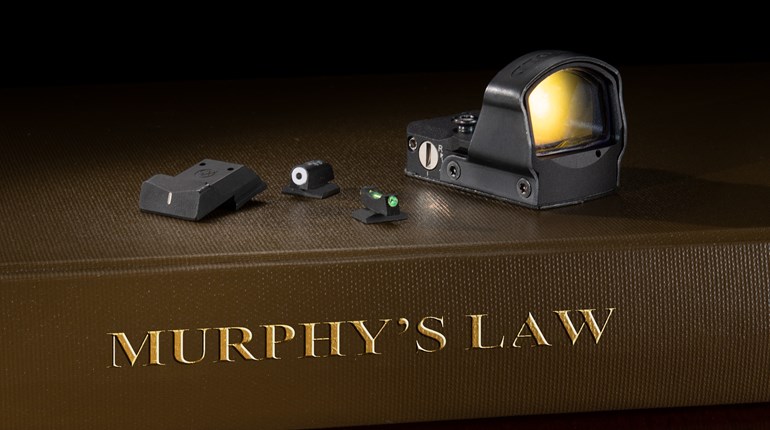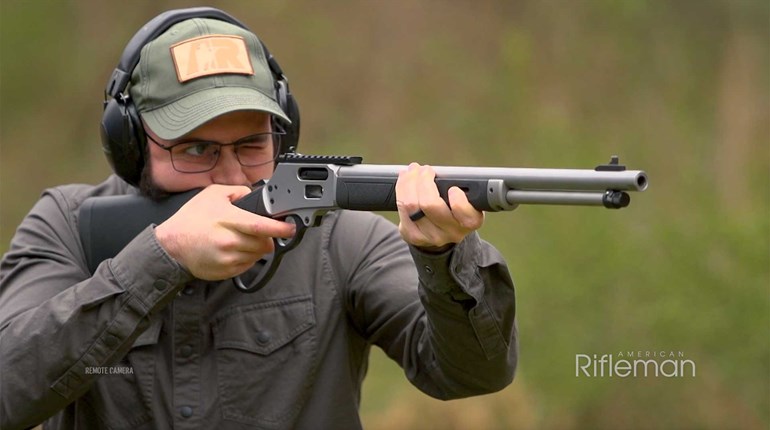
The .32 Hand Ejector I-frame (Model of 1903 shown) was a belt gun. Though the subsequent J-frames like the Model 31-1 could also be belt guns, the real impact of J-frames has been as small, concealable revolvers like the ultra-modern Model 360PD.
As I write this, I’m dog-sitting for friends at their house in the remote New England woods. It’s serene and quiet, off the beaten path and unless I’m planning on running an errand into town on any given day, there’s not a lot of incentive to change out of sweatpants and house slippers.
It’s for just such days that I fitted a trusty Smith & Wesson Model 43C with a DeSantis Clip Grip. The little double-action-only J-frame—with its aluminum-alloy cylinder bored with eight charge holes for .22 LR ammo—weighs next to nothing when tucked into the waistband of sweats or yoga pants. Their light weight and easy-shooting nature has made them something of a cult classic since they were introduced in 2010.
Totally coincidentally, I brought another revolver on the trip to write up for a different project. It was all-steel, much heavier, much older and held only five rounds as opposed to the eight of the 43C, and yet the two were practically kin.
That older revolver is a Smith & Wesson .38/32 Terrier, which was the first modern small-frame Smith & Wesson Hand Ejector designed as a piece specifically for deep-concealment, carry-gun use. The old Terrier, which is the direct ancestor of the venerated Chiefs Special and all subsequent J-frame snubby carry guns, may seem quite different from the all-alloy DAO 43C, but they’re so alike they’ll interchange most grips and holsters. Their lockwork is substantially unchanged, save for relatively minor details, and they’re part of an unbroken line that makes even long-established designs like the 1911 or PPK seem like newcomers.
The Smith I-frame didn’t start out as a concealable pocket gun. Its roots lie with the first .32 Hand Ejector Model of 1896, which only came in barrel lengths between 3.25 and 6 inches. This was a little different from the modern Hand Ejectors in that the cylinder stop was in the top of the frame and there was no thumb release for the cylinder, which was instead operated by pulling forward on the ejector rod. But with the Model of 1903, these parts had moved into their familiar locations, where they remain more than a century later.
For the first part of the I-frame’s existence, it was a pistol for regular belt holsters, available as a six-shot .32 or the five-shot .38 Regulation Police in .38 S&W. In 1936, however, Smith & Wesson combined the five-shot .38 Regulation Police cylinder with a round-butt frame and a 2-inch barrel to create the “Terrier,” and thus was born an entire genre of Smith & Wesson small, concealable, carry revolvers.
After World War II, the I-frame was switched from a leaf-type mainspring to a coil mainspring to become the “Improved-I,” and then the cylinder window was slightly lengthened to allow a cylinder long enough to chamber the .38 Spl. round, creating the now-classic Chiefs Special—the first of the “J-frames.”
The family was expanded to include aluminum-frame revolvers in the 1950s with the Airweight Chiefs Special. Also debuting in 1952 was an enclosed-hammer DAO variant called the “Centennial,” to commemorate the then-upcoming hundredth birthday of the Springfield, MA. company. Since DAO wasn’t every shooter’s cup of tea, next was a version with a shroud that mostly enclosed the hammer, leaving only a nub of the hammer spur exposed. Called the Bodyguard, this kept the hammer from snagging when drawn from a pocket, yet still allowed the revolver to be cocked for single-action shooting.
In the 1960s, stainless steel joined carbon steel and aluminum as an option for frame material, debuting in the Model 60, the Chiefs Special Stainless. As time went on, even more options became available: More chamberings were offered, too, such as .32 H&R Mag. and even .357 Mag. Even lighter variants were made with titanium cylinders, creating the popular AirLite series.
Like the menu at a build-your-own-burger joint, these various feature sets have been assembled by the company in a bewildering variety of combinations: The Model 642 .38 Spl.Centennial Airweight Stainless, the Model 331 .32 Mag. Chiefs Special AirLite Ti, the Model 640 .357 Mag. Bodyguard Stainless or the leading-edge Model 360PD .357 Mag. AirLite.
With such a wide variety of feature sets, it’s no wonder the small-frame Smith wheelgun is still as popular as it is. There’s a version offered for nearly any task you could want a pocket-size revolver to fulfill. Whether it’s a small gun, yet with .357 Mag. punch but some steel-frame heft to soften the recoil, a lightweight .38 for an on-duty backup in an ankle holster or just a little something that won’t pull your sweatpants down when you walk out to get the mail in the New England woods—like I should go do now.






































